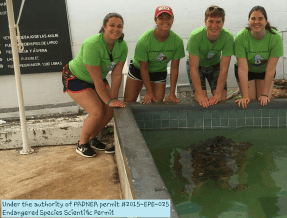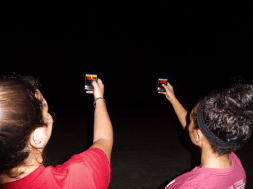The Assessment and Educational Outreach of Lighting Practices for Coastal Light Pollution Impacting Sea Turtle Ecosystems
 Sponsoring organization: Junta de Calidad Ambiental & Departamento de Recursos Naturales y Ambientales
Sponsoring organization: Junta de Calidad Ambiental & Departamento de Recursos Naturales y Ambientales
Team members: Liam Beal (Civil Engineering ’18), RiAnna May (Civil Engineering ’18), Celeste Nicoletti (Industrial Engineering ’18), Maria Snyder (Biology & Biotechnology ’18)
Executive Summary: As the world and society continue to grow, the amenities, benefits, and consequences that go along with it grow as well. Every day, artificial light continues to be a problem by polluting the environment and damaging aspects of life that may never be recovered. This is referred to as light pollution and there are multiple components which are covered by this term. Skyglow, light trespass, glare, and clutter are the four main components and are described as brightening of the night sky over inhabited areas, light falling where it is not intended or needed, excessive brightness that causes visual discomfort, and bright, confusing, and excessive groupings of light sources respectively (“Light Pollution,” 2016). Skyglow and trespass are the two components that have the greatest impact on the environment because they permeate the ecosystems of many different species.
Light pollution is defined by the International Dark Sky Association (IDA) as “the inappropriate or excessive use of artificial light which has a disruptive effect on natural cycles” (“Light Pollution”, 2016). Sea turtles use the natural light from the moon and stars to find their way back to the ocean from beaches. Without artificial light, the moon reflecting off the ocean ends up being the brightest area seen from the coast. However, on many of the coastal locations in Puerto Rico, there are high levels of artificial light and the turtles therefore instinctively stray away from the ocean. Nesting female sea turtles look for the darkest and quietest locations to lay their eggs. If there is too much artificial light on the beach, they feel unsafe and will look for other beaches even though they may be less than optimal. This can result in fewer, if any, eggs hatching. Light pollution also greatly affects hatchlings because when they emerge from their nests, they look for the brightest point which is naturally the moon and stars reflecting off the ocean. However, if there are many sources of artificial light, this can confuse the hatchlings.
They can end up going towards the lights and risk dying from dehydration, exhaustion, terrestrial predation, and cars. Although we primarily focused on the effects that light pollution has on sea turtles because they are an endangered species, light pollution also affects other forms of wildlife such as frogs, birds, and moths.
With the growing amount of pollution, agencies have begun to implement laws, rules, regulations, and restrictions to reduce light pollution and its adverse effects. In Puerto Rico, light pollution is a concern because of its negative impacts on coastal ecosystems including sea turtles and marine life. With the specific limitations from the Puerto Rican government, there should be no light pollution impacting the coastal environment. Two organizations in Puerto Rico, the Junta de Calidad Ambiental (Environmental Quality Board) and the Departamento de Recursos Naturales y Ambientales (Department of Natural and Environmental Resources), are responsible for enforcing and regulating the specifics about the law and regulations. The law (No. 218) was passed in 2008 and a transitional period was established as 10 years for private lighting and 20 years for public lighting. During this time, the government is not allowed to force owners to replace noncompliant light fixtures but instead they can demand the modification of fixtures.
One major problem that government agencies have encountered is that people cannot afford to modify their lighting. These regulations and issues are the purpose behind our project and effor ts.
ts.
Methodology and Results
The goal of our project was to evaluate lighting practices and modifications to reduce light pollution and provide educational outreach in an effort to protect sea turtle nests on the coasts of Puerto Rico. To accomplish this, we broke our project into three main parts: data and inventory collection, distribution of a survey, and creating an educational brochure and guide as deliverables.
We evaluated lighting practices in Isla Verde by measuring light levels using a photometer and a sky quality meter (SQM). The photometer was used to measure the intensity of a light and its units were in foot candles (fc). The higher the reading, the brighter the light and the greater the light pollution. The average maximum reading per property was 2.34 fc.
Compared to the allowable level as required by the regulation of 0.05 fc, the majority of the lights were not in compliance. The sky quality meter was used in phase 1 in Isla Verde to measure the illuminance of the sky. The units were magnitudes per square arcsecond (mpsas) and the lower the reading, the more illuminance there was in the area. The average SQM reading from 19 locations in phase 1 was 17.76 mpsas. Compared to the 2014 IQP team with an average reading of 18.33 mpsas, the SQM readings at Isla Verde have decreased significantly. This indicates that light pollution has increased over the past two years.
While collecting data at night, we also performed an inventory evaluation of the light fixtures in Isla Verde and Patillas. We performed a thorough inventory collection of lights from every building that faced the beach or was close in proximity to the beach. At each building we took two pictures of every type of light fixture that was visible; one picture close up and another farther out. The lights were organized on a chart with the following categories: light identification number, quantity of lights on the property, location, photos of the light, type of light, light application, light color, whether the angle exceeded 70 degrees, shielding, number rating of compliance, average photometer readings, and recommendations.
In Isla Verde, 843 lights were assessed and from the results, a majority of the light fixtures were found to not be in compliance with the law. In terms of the color of the light bulb, 12% of the lights were compliant for light bulb color, 28% had a noncompliant light bulb color, and 60% of the lights were not able to be assessed for color. In terms of shielding, 2% had a compliant shield, 82% needed a shield added or painting of an existing shield, 13% needed a shield added and the angle of the light to be changed, and 3% needed the fixture to be removed. In Patillas, we were not able to conduct an inventory evaluation as thorough as in Isla Verde due to time constraints, however we were able to determine if light fixtures were not in compliance by shielding and the angle of the light. Of the 130 lights assessed, 25% were determined to be possibly compliant and 75% were noncompliant. We ultimately determined that most of the lights found in both communities were noncompliant with the law and needed to be modified.
After we edited our survey questions, the survey was translated into Spanish with the help of our sponsors at the Junta de Calidad Ambiental. Our final survey gathered information about the age groups of the respondents, their role in the community, their level of knowledge about the light regulation, the willingness of the community members to modify their own exterior light fixtures, and the amount of money that they were willing to spend on these modifications. The survey was distributed through a direct link on a piece of paper as well as physical hard copies of the survey on a clipboard. We walked around the community of Isla Verde and tried to get responses from different age groups and community members so that we would have a variety of answers.
Once we had all the survey responses, we formed conclusions regarding the level of knowledge the public had about the light regulations, the modifications we needed to design, and the information to include in our educational material for the community. We concluded that about half of the respondents did not know about or understand the light regulations. Many of the respondents were willing to modify their lighting fixtures, and the most popular modifications were angling the light downwards and away from the property line, changing the bulb color and intensity, and using an automatic timer to turn the lights off when they were not in use. The main factors that persuaded community members to consider modifying their exterior lighting were to avoid receiving a fine, help protect an endangered species, and to save money on energy costs.
After the inventory was created and the survey responses were analyzed, we were able to construct our educational brochure and guide. The brochure was a double sided tri-fold which included information about the light regulations that pertain to the beach areas that sea turtles are found on, as well as an explanation about how sea turtles are affected by light pollution. The brochure also included before and after pictures of modifications that we created on the four most common light fixtures that were found. The pictures were followed by the materials that were used to create the modifications along with the average cost. The educational guide is a little longer than the brochure because it goes into more depth about the negative effects of light pollution on the sea turtles, step by step instructions on how to create modifications, and resources that community members can use to learn more about light pollution, sea turtles, and the steps they can individually take to help reduce light pollution.
Recommendations
It is evident from our investigations in Isla Verde and Patillas that the vast majority of light fixtures do not meet the requirements defined by the law and regulation in effect. There are many factors that contribute to this lack of compliance and awareness including general awareness of the law and monetary implications on owners. Therefore, the following recommendations are geared toward taking steps to resolve these issues.
- We recommend targeting the lighting suppliers to push for more compliant lighting fixtures and modification Based on our findings, we have determined that there are significantly more noncompliant light fixtures available contrary to compliant ones. Modification pieces available for purchase are sparse. If the market was influenced toward the production of more compliant options, then it would be much easier and simpler for people to abide by the requirements of the law. This is a world-wide initiative and we realize that major transitions would need to take place. Therefore, we propose a preliminary step in an effort to make people more aware of the regulation by making informational pamphlets available throughout lighting aisles in hardware stores. We attended a local hardware store to purchase test lights and could not find any information on compliant lighting or even International Dark Sky information. By targeting the source where community members seek the product, we believe the awareness of the lighting problems will drastically increase.
- We recommend community outreach through kiosks and educational programs implemented in the schooling Similar to the informational hut that exists in phase 1 of Isla Verde, other locations could benefit from the utilization of booths where associates and/or volunteers could distribute brochures and guides alike the ones we developed. Many residents do not have the means to purchase brand new lighting fixtures that are compliant, so it is important for people to be aware that there are affordable, do- it-yourself options. Another outlet for information is schools. Kids are already there for the purpose of learning so it is a justified location to inform people about the regulation. We believe all ages can understand the implications of the law and the positive effects it has on the environment. For this reason, we intend that programs can be implemented in elementary through high school levels.


